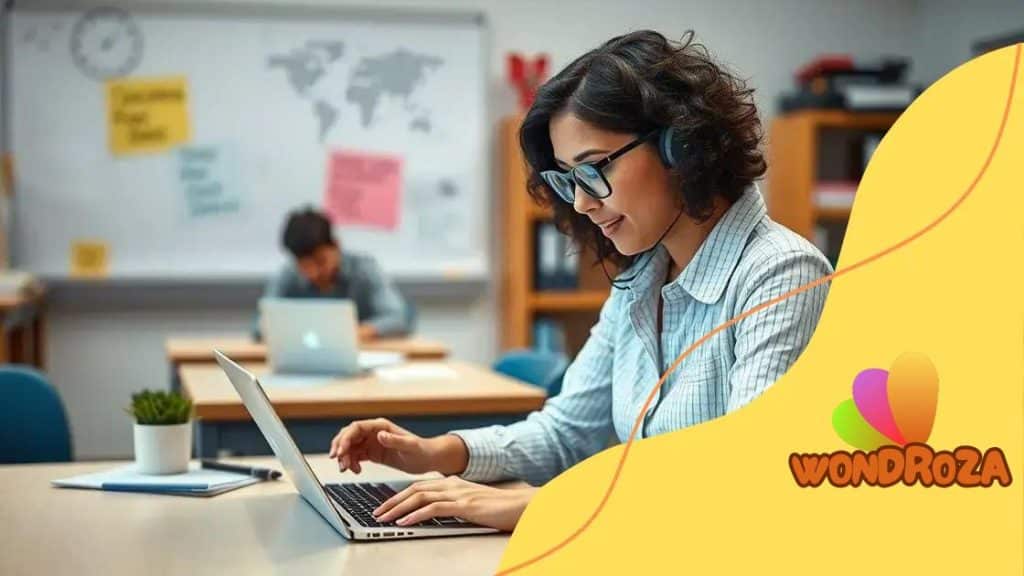Digital tools to enhance teacher productivity and effectiveness

Digital tools enhance teacher productivity and effectiveness by streamlining administrative tasks, increasing student engagement, and personalizing learning experiences through interactive technologies and data-driven insights.
Digital tools to enhance teacher productivity and effectiveness are changing the educational landscape. Imagine having more time to engage with students while administrative tasks are streamlined. This article will explore innovative tools that can make a real difference in your teaching routine.
Understanding the importance of digital tools in education
Understanding the importance of digital tools in education is essential for modern teachers. These tools can greatly enhance both teaching effectiveness and student engagement. With the right resources, teachers can streamline their workflow and focus more on their students’ needs.
Why Digital Tools Matter
Digital tools facilitate communication, organization, and creativity in the classroom. By incorporating technology, educators can present information in more interactive ways that appeal to diverse learners. For example, tools like interactive whiteboards make lessons more captivating and encourage student participation.
Benefits of Utilizing Technology
Embracing digital tools offers numerous advantages:
- Enhanced Collaboration: Tools like Google Classroom allow for seamless collaboration among teachers and students.
- Access to Resources: Teachers can find a wealth of information online that can supplement their curriculum.
- Personalized Learning: Technology enables customized learning experiences that cater to individual student needs.
Incorporating these tools into daily lessons helps teachers manage their tasks more efficiently. With applications for grading, feedback, and lesson planning, educators can reduce administrative burdens and increase their focus on teaching. This not only benefits the educators but also impacts students positively, leading to a richer learning experience.
As educational technology continues to evolve, the potential for enhancing the learning environment grows. Staying updated on the latest digital tools equips teachers with the knowledge to adapt their methods. Ultimately, understanding and utilizing these tools is vital for creating engaging and effective educational experiences.
Top digital tools for effective lesson planning
Top digital tools for effective lesson planning can change the way educators create and execute their lessons. By utilizing technology, teachers can save time and enhance the quality of their instructional materials. With the right tools, planning can become a more dynamic and engaging process.
Popular Tools for Lesson Planning
Here are some excellent digital tools that educators often use:
- Google Classroom: This platform allows teachers to create, distribute, and grade assignments online.
- Nearpod: An interactive presentation tool that helps engage students with quizzes and polls during lessons.
- Microsoft OneNote: A digital note-taking app that lets teachers organize lesson plans collaboratively.
Using these tools, educators can easily customize their lesson plans. For instance, Google Classroom helps streamline communication with students, ensuring everyone is on the same page. Moreover, incorporating interactive elements with tools like Nearpod enhances student engagement significantly.
Benefits of Using Digital Tools
Several advantages come with using digital tools for lesson planning:
- Efficiency: Automating routine tasks means more time for creativity.
- Accessibility: Lesson materials can be accessed from anywhere, making collaboration easier.
- Flexibility: Adjustments can be made quickly based on student feedback and learning progress.
In addition to these benefits, sharing lesson plans with colleagues becomes easier. Digital tools often feature sharing options that promote teamwork among teachers. This collaborative spirit can lead to the creation of more effective and diverse lesson plans, benefiting the entire classroom experience.
Staying updated with the latest educational technologies empowers teachers. Adopting these digital tools inspires confidence and innovation in lesson planning, making education a more engaging process for both teachers and students.
How digital tools improve student engagement

How digital tools improve student engagement is a key aspect of modern education. Today, many educators are discovering that leveraging technology makes learning more interactive and enjoyable for students.
Interactive Learning Experiences
Digital tools can provide interactive learning experiences that capture students’ attention. For instance, using platforms like Kahoot! makes quizzes fun and competitive. Students are more likely to participate when they feel engaged through games and challenges.
Real-Time Feedback
Another advantage is the ability to provide real-time feedback. Tools like Google Forms or Quizizz let students receive immediate responses to their answers. This instant feedback helps students understand where they need to improve.
Furthermore, technology allows for personalized learning. Students can work at their own pace using educational apps tailored to their individual needs. This means they can revisit complex topics until they feel confident. Such flexibility caters to diverse learning styles, making education inclusive.
Collaboration and Communication
Digital tools also enhance collaboration and communication among students. Platforms like Padlet and Flipgrid encourage group work where students can share ideas and projects online. Collaborative projects foster a sense of community and motivate students to engage more deeply with the material.
Moreover, using multimedia resources, such as videos and podcasts, can make lessons vibrant and relatable. For example, incorporating engaging visual content helps students to grasp complex concepts and retain information more effectively.
As technology continues to evolve, the potential to boost student engagement expands as well. Educators must stay informed about new tools and strategies to create a stimulating learning environment. By adopting digital tools, teachers can embolden students to participate actively in their education, leading to better learning outcomes.
Strategies for maximizing productivity with technology
Strategies for maximizing productivity with technology are essential for educators aiming to enhance their teaching effectiveness. By adopting certain approaches, teachers can leverage digital tools to streamline their workflows and focus more on student interaction.
Utilize Planning Tools
One effective strategy is to utilize planning tools like Asana or Trello. These platforms help educators organize tasks, set deadlines, and track progress. With clear visibility on assignments and projects, teachers can prioritize their workflow and manage their time effectively.
Automate Routine Tasks
Another approach is to automate routine tasks. Automation tools such as IFTTT or Zapier can help eliminate repetitive actions, such as sending reminders or updating schedules. By automating these tasks, educators free up valuable time that can be better spent on lesson preparation and student engagement.
In addition to these strategies, adopting collaborative platforms like Google Workspace can improve productivity. These tools allow teachers to work together on projects, share resources, and communicate in real time. This not only fosters teamwork among educators but also contributes to a more efficient learning environment for students.
Embrace Professional Development
It’s also important for educators to embrace professional development opportunities. By attending workshops or online courses focused on technology integration, teachers can discover new tools and strategies. Staying updated with technology trends ensures that educators can utilize the most effective resources available.
Lastly, setting specific technology goals can help teachers stay focused. By identifying areas where technology can enhance productivity, educators can create actionable plans that lead to improved efficiency in their daily tasks. Over time, these strategies can significantly improve the overall teaching experience.
Future trends in digital tools for educators
Future trends in digital tools for educators are exciting and filled with potential. As technology continues to evolve, teachers will have access to new and innovative tools that can significantly transform the classroom experience.
AI-Driven Personalization
One major trend is the increasing use of artificial intelligence to personalize learning. AI can analyze student performance data and suggest tailored resources and activities. This allows educators to meet individual student needs more effectively, enabling them to provide customized support for every learner.
Virtual and Augmented Reality
Another trend is the rise of virtual and augmented reality in education. These technologies create immersive experiences, making learning more engaging. For example, students can take virtual field trips or explore complex topics in 3D, enhancing their understanding through interactive simulations.
Moreover, the use of data analytics will likely increase. Educators can gain insights from student data to improve teaching methods and curricula. With analytical tools, teachers can track progress and identify areas needing improvement, making their instruction more effective.
Collaboration Platforms
Collaboration platforms will also continue to develop. Tools that facilitate group work and communication will enhance teamwork among students and educators. Features like shared documents, video conferencing, and project management within these platforms will drive more collaborative projects.
Finally, an increasing focus on social-emotional learning tools can help educators support students’ mental health. Digital resources aimed at building social skills and resilience will become more available, ensuring a holistic approach to education in the digital age. Overall, these future trends will continue to change the educational landscape, enhancing the way teachers and students interact.
FAQ – Questions about Digital Tools in Education
How can digital tools enhance teacher productivity?
Digital tools help teachers automate routine tasks, organize lesson plans, and streamline communication, allowing more time for effective teaching.
What are some examples of digital tools for student engagement?
Tools like Kahoot!, Nearpod, and Google Classroom create interactive and collaborative learning experiences that keep students engaged.
How does artificial intelligence personalize learning?
AI analyzes student data to tailor educational content and activities to meet individual learning needs and preferences.
What future trends should educators be aware of?
Educators should look out for trends like AI-driven personalization, virtual reality in lessons, and collaborative platforms that enhance teamwork.





